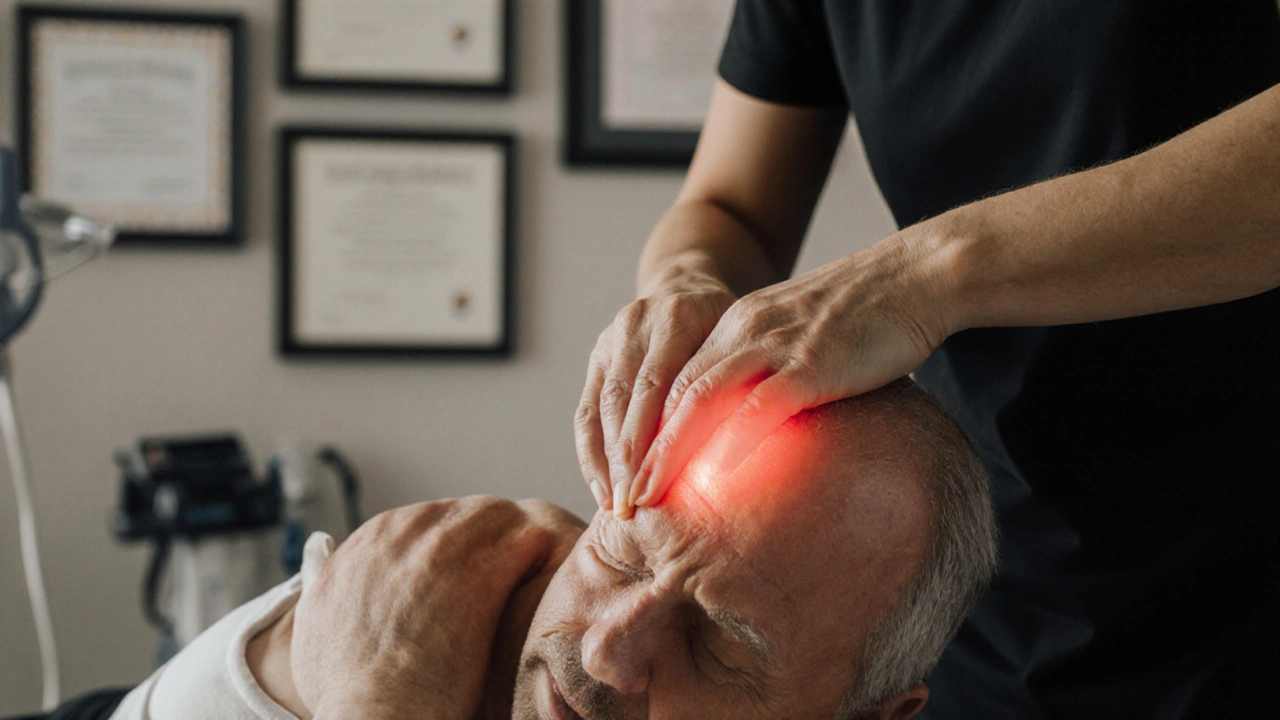Learn how to turn your massage session into real recovery-not just relaxation. Discover what to do before, during, and after to get lasting relief from tension, pain, and stress.

- Created by: Archer Caldwell
- Completed on: 14 Nov 2025
- Categories: Massage Therapy
You’ve been living with back pain for months. Maybe it’s from sitting too long at a desk, or an old injury that never fully healed. You’ve tried ice packs, painkillers, even stretching routines-but nothing gives you real, lasting relief. Then someone suggests seeing a massage therapist. You’re skeptical. Is this just another luxury spa treatment? Or could it actually help?
The truth? A licensed massage therapist isn’t just someone who gives relaxing rubdowns. They’re trained healthcare professionals who use hands-on techniques to reduce pain, improve movement, and help your body heal. And for millions of people with chronic pain, they’re a game-changer.
What a Massage Therapist Actually Does for Pain
A massage therapist doesn’t guess what’s wrong. They assess. They ask questions: Where does it hurt? When did it start? Does it shoot down your leg? Do you feel numbness? Then they use their hands to feel for tight muscles, trigger points, swelling, or asymmetries in your posture. This isn’t just a feel-good session-it’s a physical evaluation.
Once they understand your pain pattern, they pick the right technique. Maybe it’s deep tissue work to break up scar tissue around a herniated disc. Or myofascial release to loosen the thickened connective tissue that’s pulling your spine out of alignment. Maybe it’s trigger point therapy to quiet down that knot in your shoulder that’s causing headaches.
Studies from the Journal of Pain show that regular massage therapy reduces pain intensity by 30-50% in people with chronic lower back pain. That’s not a placebo. It’s measurable. And it works because massage changes how your nervous system processes pain signals.
Why Massage Works When Medication Doesn’t
Painkillers mask pain. They don’t fix the root cause. And long-term use can bring side effects-stomach issues, liver damage, dependency. Massage does something different: it addresses the physical source.
When muscles stay tight for too long, they compress nerves and restrict blood flow. That’s when pain flares up. A massage therapist releases that tension. Increased circulation brings oxygen and nutrients to damaged tissues. Reduced muscle spasms mean less pressure on joints and nerves. And here’s the kicker: massage lowers cortisol (your stress hormone) and boosts serotonin and dopamine. That means less pain perception and better mood-two things that go hand-in-hand with chronic pain.
One woman I worked with had fibromyalgia. She was on three medications and still woke up in pain every day. After six weeks of weekly massage sessions focused on myofascial release and gentle stretching, she cut her pain meds in half. She told me, “It’s not that the pain disappeared. It’s that I finally feel like I can move again.”
Types of Massage Used in Pain Management
Not all massage is the same. For pain, it’s about matching the technique to the problem:
- Deep Tissue Massage - Targets deeper layers of muscle and connective tissue. Best for chronic stiffness, sports injuries, or post-surgery scar tissue.
- Myofascial Release - Focuses on the fascia, the web-like tissue surrounding muscles. Helps when pain feels widespread, like in fibromyalgia or chronic tension.
- Trigger Point Therapy - Applies focused pressure to specific knots that refer pain to other areas (like a tight trap muscle causing neck pain or headaches).
- Swedish Massage - Lighter pressure, great for reducing overall stress and improving circulation. Useful for people whose pain is worsened by anxiety.
- Neuromuscular Therapy - A clinical approach that combines trigger point work with posture analysis. Often used in physical therapy settings.
A good massage therapist will adjust their approach based on your condition. If you have arthritis, they won’t press hard on inflamed joints. If you’re recovering from surgery, they’ll avoid certain areas entirely. It’s not one-size-fits-all.
Who Benefits Most from Massage Therapy for Pain?
You don’t have to be an athlete or an office worker to benefit. Here are the most common groups who see real results:
- People with chronic lower back pain (the #1 reason people seek massage for pain)
- Those with osteoarthritis in knees or hips
- Individuals with fibromyalgia or chronic fatigue syndrome
- Recovering from car accidents or whiplash
- Patients with sciatica or nerve compression
- People with tension headaches or migraines triggered by neck/shoulder tightness
Even people with cancer-related pain or post-chemo fatigue find relief through gentle, adapted massage. It’s not about deep pressure-it’s about calming the nervous system.

What to Expect During Your First Session
First-time clients often worry they’ll be asked to undress completely. You won’t be. You’ll be covered with a sheet the whole time-only the area being worked on is exposed. Privacy and comfort are non-negotiable.
Your therapist will start by asking about your pain history, medical conditions, and what you hope to achieve. Then they’ll have you lie on the table. The room is warm, the lights are low, and the music is soft. You might feel some discomfort during deep work, but it should never be sharp or unbearable. If it is, speak up. A good therapist will adjust immediately.
Afterward, you might feel a little sore-like after a good workout-but that usually fades in 24 hours. Most people report feeling lighter, calmer, and less tense. Some even sleep better that night.
How Often Should You Go?
There’s no magic number, but here’s what works for most people:
- Acute pain (lasted less than 3 months): 1-2 sessions per week for 3-6 weeks, then taper off.
- Chronic pain (lasting 6+ months): Once a week for 4-8 weeks, then every 2-4 weeks for maintenance.
- Preventative care: Once a month to keep tension from building up.
Insurance doesn’t always cover massage therapy-but more are starting to. Some workers’ comp plans and Medicare Advantage plans now include it as a benefit. Always ask your provider.
Massage Therapist vs. Physical Therapist: What’s the Difference?
People often confuse the two. Here’s the breakdown:
| Aspect | Massage Therapist | Physical Therapist |
|---|---|---|
| Primary Focus | Soft tissue release, circulation, nervous system calming | Movement restoration, strength, joint function |
| Techniques Used | Hands-on pressure, stretching, myofascial work | Exercises, stretches, machines, ultrasound, electrical stimulation |
| Session Length | 60-90 minutes | 30-60 minutes |
| Goal | Reduce pain, relax muscles, improve comfort | Restore mobility, rebuild strength, prevent re-injury |
| Best For | Chronic tension, stress-related pain, fibromyalgia | Post-surgery recovery, sports injuries, joint stiffness |
Many people benefit from both. A physical therapist might help you strengthen your core after a back injury. A massage therapist can loosen the tight muscles around it that are pulling you out of alignment. They work together.

Red Flags to Watch Out For
Not everyone calling themselves a “massage therapist” is qualified. Here’s how to spot a real professional:
- They have a state license or certification (check their credentials online).
- They ask about your medical history and pain patterns-not just “where does it hurt?”
- They don’t promise to “cure” your pain. Realistic expectations are key.
- They avoid massaging areas with open wounds, blood clots, or recent fractures.
- They respect your boundaries. No pressure to undress more than you’re comfortable with.
If someone pushes you to buy a package of 20 sessions upfront or claims massage can replace surgery or medication, walk away.
How to Find a Qualified Massage Therapist
You wouldn’t go to an unlicensed dentist. Same goes for massage.
- Search for licensed massage therapist (LMT) or certified massage therapist (CMT) on directories like the American Massage Therapy Association (AMTA) or Associated Bodywork & Massage Professionals (ABMP).
- Look for therapists who list “pain management,” “clinical massage,” or “medical massage” as specialties.
- Ask your doctor or physical therapist for a referral. They often work with trusted massage professionals.
- Read reviews that mention pain relief-not just “relaxing” or “romantic.”
Don’t just pick the cheapest option. A skilled therapist with experience in pain conditions is worth the investment.
Can Massage Therapy Replace Other Treatments?
No. But it can make them work better.
Massage doesn’t fix a herniated disc. But it can reduce the muscle spasms that make the pain worse. It doesn’t cure arthritis. But it can improve joint mobility by loosening surrounding tissue. It’s a supportive tool-not a standalone cure.
The most successful pain management plans combine massage with movement (like walking or yoga), proper sleep, stress reduction, and medical care when needed. Massage fits right in the middle-as the human touch that helps your body respond to other treatments.
Can massage therapy help with nerve pain?
Yes, but it depends on the cause. If nerve pain comes from muscle compression-like sciatica from tight piriformis muscles-massage can relieve the pressure. If it’s from diabetic neuropathy or spinal cord damage, massage won’t fix the nerve itself, but it can reduce surrounding inflammation and improve circulation to ease discomfort.
Is deep tissue massage safe for older adults?
Absolutely-if done correctly. Many seniors benefit from gentle deep tissue work to relieve stiffness from arthritis or inactivity. A skilled therapist will adjust pressure and avoid areas with thin skin, osteoporosis, or recent fractures. Always disclose your full medical history.
How soon after an injury should I see a massage therapist?
For acute injuries (first 48-72 hours), avoid deep massage. Ice and rest are better. After that, gentle massage can help reduce swelling and prevent scar tissue buildup. Always check with your doctor first, especially if you have fractures, dislocations, or blood clots.
Does massage therapy hurt?
It shouldn’t. Some discomfort is normal with deep tissue work-think of it as a "good hurt," like stretching a tight muscle. But sharp, burning, or electric pain means you’re being pushed too hard. Speak up immediately. A good therapist will adjust.
Can I get massage therapy if I have high blood pressure?
Yes, and it may help. Studies show massage can lower blood pressure by reducing stress hormones. But avoid aggressive techniques if your BP is uncontrolled. Let your therapist know your condition so they can use calming, rhythmic strokes instead of deep pressure.
If you’ve been living with pain, you don’t have to just endure it. A massage therapist doesn’t just touch your muscles-they help your body remember how to feel better. It’s not magic. It’s science. And it’s accessible.
Start small. One session. See how you feel. Your body might surprise you.
Explore what goes on in the world of massage therapy—benefits, session experiences, safety tips, price info, and practical, real-life advice.
If you're constantly tense, tired, or stiff, your body might be begging for a massage. Discover the 10 clear signs you need to see a massage therapist in London-and why waiting could make things worse.




Lise Cartwright
November 14, 2025 AT 21:24i just think all this massage stuff is a scam lol. like, sure, it feels nice for 20 minutes, but then you’re back to hurting the next day. they’re just selling you a warm hug and calling it medicine. my aunt tried it for her back and ended up spending $2k and still needed surgery. capitalism is genius, man.
Erika King
November 15, 2025 AT 00:36okay but like… i had a 3-year chronic back thing from sitting at my laptop all day, and i was ready to give up. then i went to this one therapist who didn’t even use oils, just her hands and this weird foam roller thing, and after 4 weeks? i could bend over without screaming. it’s not magic, but it’s not placebo either. my dog even noticed i was less grumpy. i’m not even kidding. now i go every 3 weeks like it’s my therapy. also, the room had a plant. small wins.
Keenan Blake
November 16, 2025 AT 17:58This is a well-researched and clinically grounded overview. The distinction between massage therapy and physical therapy is particularly important-many patients conflate the two, leading to misaligned expectations. The physiological mechanisms cited-reduced cortisol, increased serotonin, improved circulation-are well-documented in peer-reviewed literature. I’d only add that the neuroplastic changes induced by repeated somatic input may contribute to long-term pain modulation beyond mere muscular relaxation. It’s a valuable adjunct in multimodal pain management.
Sylvain Menard
November 18, 2025 AT 03:09Y’ALL. I was skeptical too. I thought massage was just for rich people who wanna smell lavender while sipping chamomile tea. But after my car accident? I was in so much pain I couldn’t sleep. My PT said, ‘Go see a clinical massage therapist-don’t go to a spa.’ So I did. Six sessions. Two months later? I’m hiking again. No pills. No injections. Just hands, patience, and someone who actually listened. If you’re hurting and you haven’t tried this, you’re leaving half your healing on the table. Go. Now. Your body will thank you.
Olivia Pang
November 19, 2025 AT 01:55While the article presents a largely favorable narrative, it fails to critically interrogate the epistemological underpinnings of somatic interventions within a neoliberal healthcare framework. The conflation of ‘relaxation’ with ‘therapeutic efficacy’ is a rhetorical sleight-of-hand frequently employed by wellness industries to commodify bodily autonomy. Moreover, the uncritical citation of the Journal of Pain lacks methodological context-was the sample size adequate? Was blinding implemented? Were placebo-controlled trials conducted? The absence of such scrutiny renders this piece more akin to promotional content than evidence-based discourse. Additionally, the term ‘myofascial release’ is often used as a buzzword devoid of anatomical precision. One wonders if the author has ever read the Cochrane reviews on manual therapies.
Sophia Sterling-Angus
November 20, 2025 AT 19:11Let’s be real: this is a glorified sales pitch disguised as medical advice. Massage therapists aren’t licensed clinicians-they’re not trained to diagnose, and many operate without oversight. The ‘30-50% pain reduction’ statistic? Likely cherry-picked from low-quality studies. And the claim that massage ‘changes how the nervous system processes pain’? That’s vague neurobabble with zero mechanistic explanation. Also, why are we praising someone who ‘adjusts pressure’ like that’s a revolutionary act? Every decent human being knows not to hurt people. This article reads like affiliate marketing for ABMP.
Madi Edwards
November 22, 2025 AT 11:53Look, I used to roll my eyes at massage therapy too. I thought it was all fluff-until I got my first session after a year of migraines tied to neck tension. I didn’t cry. I didn’t have an epiphany. I just… stopped having headaches for three days. And then again after the next one. And then again. It wasn’t dramatic. It wasn’t miraculous. It was quiet. Consistent. Like someone finally turned down the volume on a noise I didn’t realize I’d been living with. I still take my meds. I still stretch. But now I also have this little ritual-once a month, I lie down, and for an hour, I let someone else hold the weight. It’s not healing. It’s just… relief. And sometimes, that’s enough.